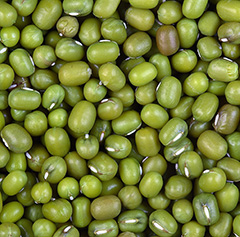| Introduction | |
| Requirement •Climate •Soil | |
| Varieties | |
| Cultivation | |
| Plant protection :Pests Aphids •Control Thrips •Control Pod borer•Control |

Green gram (Phaseolus aureus Roxb) is important pulse crops. The grains (whole or
split) are used as a pulse or made into flour, and into straw and husk
as fodder for cattle. Grains are also eaten whole (after germinating
them), parched, salted, with sugar or boiled with condiments. The
important states producing this pulse are Madhya Pradesh, Maharashtra,
Uttar Pradesh, Punjab and Andhra Pradesh, Rajasthan, Karnataka and Tamil
Nadu.
Climate
The crop needs a
well-distributed rainfall. Heavy rains at flowering are harmful, even
moist winds at this stage interfere with fertilization.
SoilThis pulse does best on deep, well-drained loams in the alluvial tract in the north as well as on the red and black soils of peninsular and southern India. It is also cultivated on light or shallow stony soils to clayey soils.
'T 1, 'T 44', 'Pusa Baisakhi', 'PS 7', 'PS 16,' 'S 8','S 9', 'Varsha (H70-16)' Hissar, ' G
65', ' Jawahar 45',' Kopergaon', ' ML 1','Ml 5',' ML 9'
For the pure crop in
the kharif season, the land is ploughed once or twice and harrowed to
obtain a rough tilth. The summer crop can be sown dry in furrows in
between the rows of the previous crop, followed by irrigation.
The kharif crop is sown
in June to July, and the rabi crop in September or October. The spring
crop is to be sown by 15 February and harvested by the middle of May.
The summer crop is sown by 15 April. The seed may be sown by
broadcasting or it may be drilled in furrows behind a plough, or with a
three-or four-coultered desi drill, in rows 20-30cm apart. The seed-rate
varies from 15-20kg per hectare when sown alone and for mixed crop 2-6kg
per hectare.
Manuring with 25-40kg
per ha of phosphorus (P2O5) and 25kg per ha of
nitrogen (N) should be given at the time sowing. Also seed treatment
with biofertilizer viz. Rhizobium at the rate of 25gram per kg of seed
is beneficial.
Being kharif crop green
gram is not required irrigation unless there is dry spell during the
kharif season. In summer irrigation should be given according to soil
type. Irrigation interval should be 8-10 days in summer. Flowering and
pod filling are the critical stages for irrigation.
Pest
1. Aphids
The nymphs and adults
suck the sap. The affected leaves turns yellow, get wrinkled and
distorted. The insect also exude honeydew on which fungus develops,
rapidly covers the plant with sooty mould that interferes with the
photosynthetic activity of the plant.
Control
Spraying with 0.05%
Endosulfan, 0.02% Phosphamidon, 0.03% Dimethoate, Methyl demeton or
Thiometon control the pest effectively.
2. Thrips
The adults and nymphs
feed on leaves. They scrape the epidermis and such the oozing sap. As a
result, light brown patches appear on infested leaves. The affected
leaves curl and become dry.
ControlSpraying with 0.05%
Endosulfan, 0.02% Phosphamidon, 0.03% Dimethoate, Methyl demeton or
Thiometon control the pest effectively.
3. Pod borer
Caterpillars feed on
tender foliage and young pods. They make holes in the pods and feed on
developing seeds by inserting anterior half portion of their body inside
the pods.
Control
In early stage of
attack handpicking of the caterpillars and their destruction. Ploughing
fields after the harvest of crop would expose the pupae, which would be
destroyed by birds. Spraying the crop with 0.05% Quinalphos or
Fenitrohion can successfully control the pest. Spray with HaNPV @ 250
LE/ha.
1. Leaf spot
Angular brown or red
spots, with grey or brown centre and reddish-purple border on leave,
stalk and pods
Control
Spray with Bordeaux
mixture (5:5:50) or 0.2% Ziram.
2. Powdery mildew
White powdery patches
on leaves and other green parts, later becoming dull coloured and are
studded with black dot.
Control
Dust the crop with
finely powdered sulphur (200-mesh) @ 20kg/ha.
To avoid loss because
of the shattering of pods, the crop is harvested before it is dead ripe.
One or two rounds of the picking of pods are also recommended to avoid
losses because of the shattering. The plants are uprooted or cut with a
sickle, are dried on the threshing-floor for a week or ten days and
threshed by beating with sticks, and are winnowed with baskets. The
average yield of grain from a pure crop varieties from 5-6q per ha,
whereas yields up to 10-15q per ha.